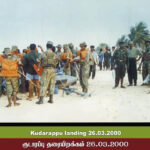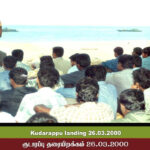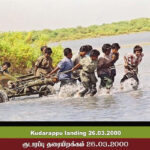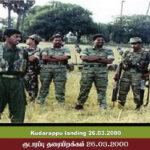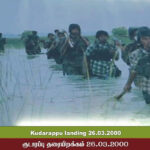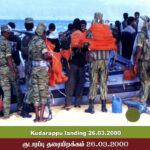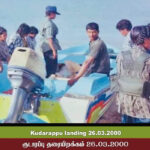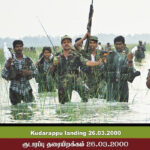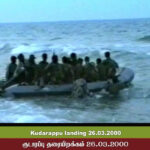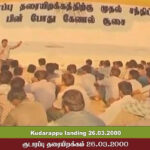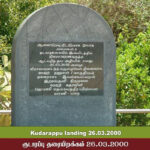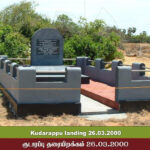

A look at the successful Kudarappu landing operation of the Tamileelam Government!
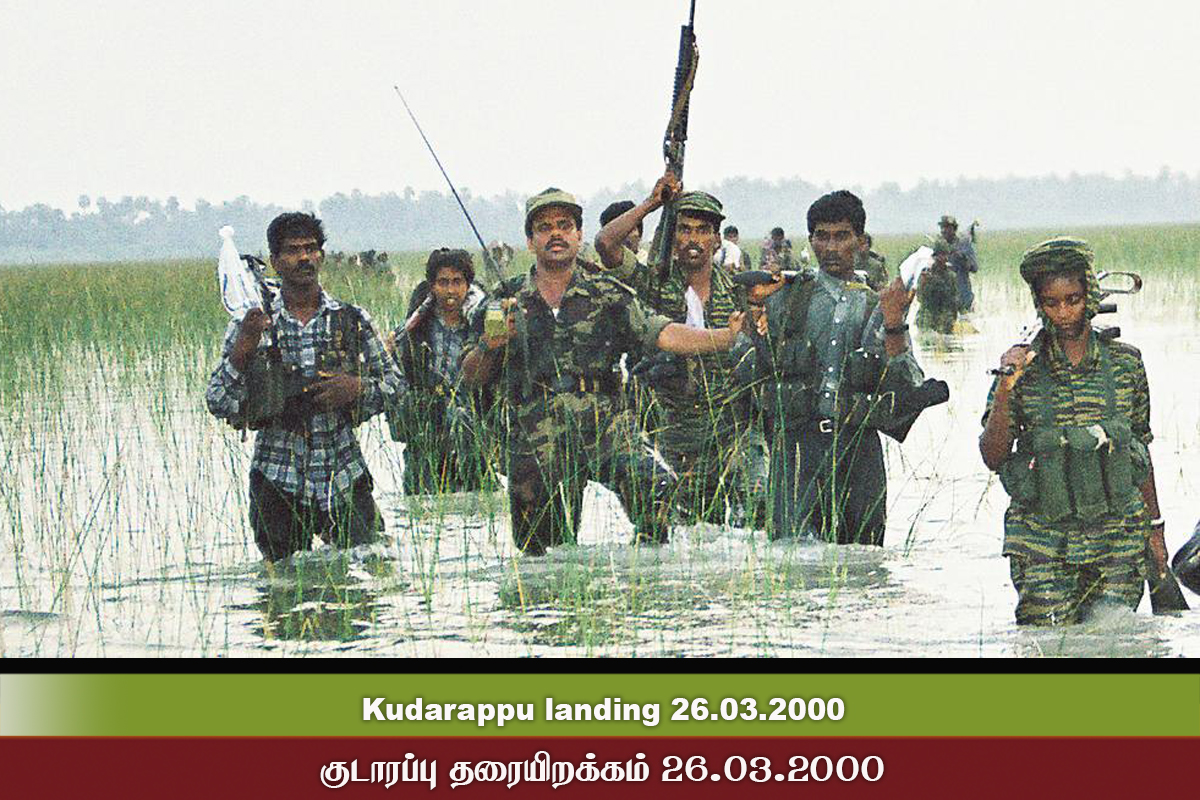
A look at the successful Kudarappu landing operation of the Tamileelam Government!
Kudarappu landing 26.03.2000
The day of the great landing operation of the Tamil fighters!
The Elephant Pass attack was an attack launched by the Liberation Tigers of Tamileelam on the evening of Sunday, March 26, 2000, against the Sri Lankan army’s occupation of Elephant Pass. The Elephant Pass base was captured by the Liberation Tigers of Tamileelam through operation “Oyaatha Alaikal 1-3”. It is noteworthy that the Elephant Pass base, which was brought under the full control of the Liberation Tigers of Tamileelam after 35 days, was guarded by more than ten thousand Sri Lankan soldiers.
The Liberation Tigers of Tamileelam carried out a large-scale military movement from Vetrilakeni by sea to land at Kudarappu. Up to 1200 LTTE fighters were forced to face attacks from the Thalaiyadi camp in the sea otter boats and went with the aim of landing in the Kudarappu area.
 The Kudarappu landing battle is one of the most important achievements in the history of the Eelam struggle. The Tamil Liberation fighters had carried out a traditional landing with strategy and resources comparable to the armies of large countries. Through this, the LTTE captured the most important military base, Anayiravu, which was considered by many to be unconquerable. It is a general rule for guerrilla fighters not to accept challenges and surrender.
The Kudarappu landing battle is one of the most important achievements in the history of the Eelam struggle. The Tamil Liberation fighters had carried out a traditional landing with strategy and resources comparable to the armies of large countries. Through this, the LTTE captured the most important military base, Anayiravu, which was considered by many to be unconquerable. It is a general rule for guerrilla fighters not to accept challenges and surrender.
In the series of operations called “Oyaatha Alaikal 1-3”, the first two phases had driven out the troops advancing on the southern and western edges of the Vanni and captured a large area of land. The third phase captured the coastal areas including Kattaikadu and Vetrilakeni at the northern tip of the Vanni. Following this, the Paranthan Army Base was also captured. The fourth phase was to begin from the captured coastal area.
On the evening of 26.03.2000, the fighters were lined up on the Vetrilakeni beach. They were ready to perform a historic and major turning point in the Eelam struggle. From Vetrilakeni, the LTTE teams were to land in the Kudarappu area by crossing the enemy-controlled Thalayadi beach by sea.
The plan was that the landed teams would cross the Kandivedi, the main supply route to the Elephant Pass, and establish themselves. The force to be landed was huge. Up to twelve hundred fighters were to be landed in one go. The enemy will try in every way to prevent the landing. The enemy will attack at sea with full naval force. They will also use direct fire from tanks from the shore to sink the Sea Tigers’ boats.
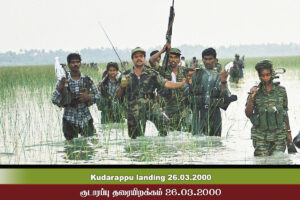 At dawn, they would have to face a fierce attack from the enemy air force. Although it was a very dangerous task, it had to be done. The Sea Tigers accepted the responsibility and carried it out efficiently. The boat that left in the evening went into the deep sea and approached the landing area in a two-hour journey. As expected, a fierce battle broke out at sea. The battle at sea began at 8.30 pm. The battle took place with a group of 16 Dorap gunboats. The Sea Tigers’ assault boats fought so that no damage was done to the boats that were to land the landing parties. Amidst fierce fighting, the teams were successfully landed on the beach before dawn. The seven supply boats that escorted the landing parties in the first stage also successfully landed the teams. The landing teams crossed the Thondamanaru watercourse and took up positions across Kandy Road by early morning.
At dawn, they would have to face a fierce attack from the enemy air force. Although it was a very dangerous task, it had to be done. The Sea Tigers accepted the responsibility and carried it out efficiently. The boat that left in the evening went into the deep sea and approached the landing area in a two-hour journey. As expected, a fierce battle broke out at sea. The battle at sea began at 8.30 pm. The battle took place with a group of 16 Dorap gunboats. The Sea Tigers’ assault boats fought so that no damage was done to the boats that were to land the landing parties. Amidst fierce fighting, the teams were successfully landed on the beach before dawn. The seven supply boats that escorted the landing parties in the first stage also successfully landed the teams. The landing teams crossed the Thondamanaru watercourse and took up positions across Kandy Road by early morning.
By the time they landed, the Karumpuli had already captured the ambush site in Palay and had neutralized eleven ambushes. Colonel Balraj directly coordinated and led all the landing teams. He was assisted by the deputy commanders of the Sothiya Brigade, Durga, the Malathi Brigade, Vidusha, the commander of the Charles Anthony Special Forces (who later died later), Lt. Colonel Rajasingh, and Ilangeeran, who had taken up the command of the Viktor Armored Resistance. No one would have dreamed that the LTTE would make such a landing. Everyone considered such efforts to be beyond the power of the LTTE and like suicide. In fact, it was like to suicide.
Having many fighters stationed in a small area inside the enemy’s territory without direct supply from the Vanni base was like suicide. It was impossible to even supply food to the landing party. The enemy offered the most fierce resistance at sea. Although they were initially stunned when they heard the news of the landing. They were clear about killing so many people. The enemy believed that they could destroy the landing party. The fact that the main fighting units of the LTTE were there and the important warlords were there made the enemy furious. They controlled that if the landing party was destroyed, the story of the LTTE would end there. The area from Vetrilakeni to Kudarappu was the strongest military base of the government forces.
Before the landing, it was clearly realized that continuous supply by sea was not possible.
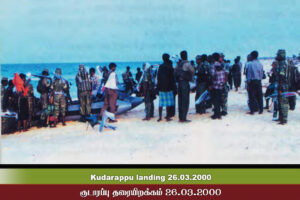 Therefore, the order was to establish supply by land. Accordingly, land was to be captured from Vetrilakeni along the coast to Kudarappu. The next day after the landing, the battle to capture the areas of Thalayadi, Maruthankerni and Sembiya and establish a connection to Kudarappu began. While fierce fighting was going on with the enemy forces who were trying to completely destroy the LTTE who had blocked the Kandy road in the Ittavil area, the LTTE fought fiercely to establish supply for the troops stationed in Ittavil. At the end of two days of fighting, the LTTE captured the strongest military bases including Thalayadi and ensured the supply of the landing force by land. The teams were reorganized, and the fighting continued.
Therefore, the order was to establish supply by land. Accordingly, land was to be captured from Vetrilakeni along the coast to Kudarappu. The next day after the landing, the battle to capture the areas of Thalayadi, Maruthankerni and Sembiya and establish a connection to Kudarappu began. While fierce fighting was going on with the enemy forces who were trying to completely destroy the LTTE who had blocked the Kandy road in the Ittavil area, the LTTE fought fiercely to establish supply for the troops stationed in Ittavil. At the end of two days of fighting, the LTTE captured the strongest military bases including Thalayadi and ensured the supply of the landing force by land. The teams were reorganized, and the fighting continued.
The enemy used all his resources to completely destroy the LTTE who were blocking the Kandy road. They used everything – armored vehicles, infantry, and soldiers. They attacked very fiercely. However, they lost to the fearless resistance of the LTTE fighters.
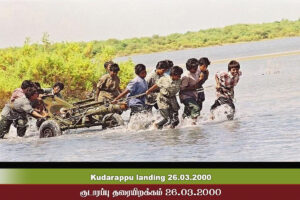 Many armored vehicles were destroyed and damaged. Since the area where the LTTE was stationed was small, it was easy for the enemy to conduct a very intensive manhunt. Those who passed through that area after the signing of the Memorandum of Understanding would have seen the area. You can see the destroyed armored vehicles standing on the side of the road and in the Ittavil area, not a single person was alive. Such a fierce bombardment was carried out on the LTTE. However, the LTTE was determined to continue holding the area and achieved success. The LTTE, led by Colonel Balraj, held the area for thirty-four days until the Elephant Pass was completely captured.
Many armored vehicles were destroyed and damaged. Since the area where the LTTE was stationed was small, it was easy for the enemy to conduct a very intensive manhunt. Those who passed through that area after the signing of the Memorandum of Understanding would have seen the area. You can see the destroyed armored vehicles standing on the side of the road and in the Ittavil area, not a single person was alive. Such a fierce bombardment was carried out on the LTTE. However, the LTTE was determined to continue holding the area and achieved success. The LTTE, led by Colonel Balraj, held the area for thirty-four days until the Elephant Pass was completely captured.
Within a few days of landing, the LTTE tried to capture Elephant Pass, which ended in failure. Then, a few days later, the LTTE devised another plan and captured the entire Elephant Pass area very easily and with minimal losses. As soon as the command post was captured, the enemy forces automatically began to flee Elephant Pass. They fled in a hurry, leaving behind all the artillery they had used.
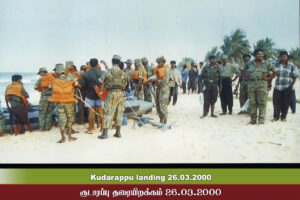 They fled via the only route they had, the Elephant Pass – the Kalaly coastal road. In the end, Elephant Pass fell to the Tamils. Not only Elephant Pass but also a huge area of land – from Kandy Road to Mukhamalai – and if you look at the eastern coast, a huge area of land from Chundikulam to Nagerkoyil was recovered.
They fled via the only route they had, the Elephant Pass – the Kalaly coastal road. In the end, Elephant Pass fell to the Tamils. Not only Elephant Pass but also a huge area of land – from Kandy Road to Mukhamalai – and if you look at the eastern coast, a huge area of land from Chundikulam to Nagerkoyil was recovered.
The Sinhalese army itself did not attempt to make such a landing. A similar landing by the government army in 1996 at Alampil ended in a huge defeat and the army had to flee again. But the LTTE landed troops very successfully and held on for more than a month, withstanding a very fierce counterattack and finally completely defeating the enemy.
The explosion of the Palay training camp
On the night of 26.03.2000, a small group of LTTE fighters was moving slowly. The first day, the Karumpulikal had infiltrated enemy territory by sea. It was a Karumpulikal unit. There were both male and female fighters in it. They were moving secretly in the area around Palay in Jaffna. At that time, Elephant Pass was in the enemy’s hands. That night, the historic Kudarappu landing was to take place. While they were moving, the Sea Tiger boats were moving at sea, covering the landing teams.
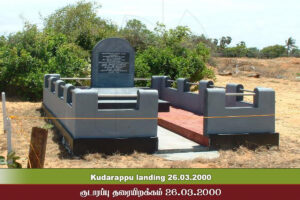 The task given to the particular Karumpuli unit was to destroy the large manpower base in Palay. Under the leadership of Karumpuli Major Varman, who had died in another battle, the unit was moving towards the Palay manpower base. It was completely under enemy control. It could come into conflict with the enemy at any time. The unit should avoid any conflicts as much as possible. It should move successfully and without the enemy knowing about it. There were a total of eleven people in the team. The team successfully moved to the specified checkpoint.
The task given to the particular Karumpuli unit was to destroy the large manpower base in Palay. Under the leadership of Karumpuli Major Varman, who had died in another battle, the unit was moving towards the Palay manpower base. It was completely under enemy control. It could come into conflict with the enemy at any time. The unit should avoid any conflicts as much as possible. It should move successfully and without the enemy knowing about it. There were a total of eleven people in the team. The team successfully moved to the specified checkpoint.
They had been conducting accurate reconnaissance for a long time. And Varman, who was currently leading the team, had already arrived at the checkpoint. So, the team was able to move easily to the target. They had come very close to the perimeter of the checkpoint. Now, they had to start the fight and break through the checkpoint and enter.
In this situation, when the team was 25 meters away from the checkpoint, the enemy started the fight. The team’s first heroic death occurred within the barrier. The Karumpuli Major Suthajini was the first to fall. As soon as the fight began, the Karumpuli launched a fierce attack and captured the checkpoint. The enemy was stunned and started running in the lightning-fast attack. They did not assume that the attacker was a small team of ten people. The hundreds of soldiers who were guarding the airfield fled the moment the fighting began.
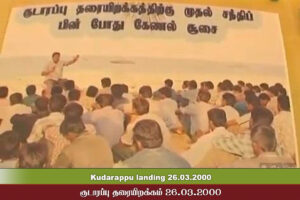 The airfield fell to the remaining ten-man team. The airfields were completely captured. There were eleven airfields in total. The enemy who had fled would come back to capture the airfield with renewed force. There were only ten men left. This was only a team to destroy the airfield. It was impossible to fight an enemy who was recapturing it. However, there was enough time.
The airfield fell to the remaining ten-man team. The airfields were completely captured. There were eleven airfields in total. The enemy who had fled would come back to capture the airfield with renewed force. There were only ten men left. This was only a team to destroy the airfield. It was impossible to fight an enemy who was recapturing it. However, there was enough time.
The enemy did not immediately attempt to capture the airfield. After controlling the airfield for a certain time, they began to neutralize the airfields as instructed by the headquarters. In this operation, Major Dhanusan, the Karumpuli, died a hero’s death. All eleven airfields were neutralized and the remaining nine returned safely. While the airfields were being destroyed, the landing took place at Kudarappu. The destruction of the airfield eliminated immediate resistance for the landing team. The Karumpulikal, who had destroyed the base, moved secretly back into enemy territory and returned safely to the base before dawn. The destruction of the Palay base was a major turning point in the Elephant Pass rescue operation. It caused great damage to the enemy. Since this destruction and the landing occurred simultaneously, the enemy was very confused and could not react immediately. They needed some time to reorganize themselves and launch an attack.
Background of the attack
Kudarappu landing – On the evening of Sunday, March 26, 2000, the LTTE fighters reached the Kudarappu area after two hours. Kudarappu landing clash – During the landing clash at 8:30 pm in the Kudarappu area, the Sri Lankan Navy warships with 16 Torap gunboats clashed.
The LTTE fighters in the landing craft were landed without any damage. Establishment on the Kandy Road – The LTTE fighters who landed in the Kudarappu area established themselves on the Kandy Road in the Ittavil area, between Thondamanar and Kadal Neereri. It is noteworthy that the main supplies to the Elephant Pass base were carried out through this Kandy Road.
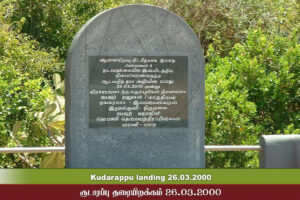 Supply links of the LTTE – The Sri Lankan army camps covering 12 kilometers from Vetrilakeni to Kudarappu were destroyed and the LTTE members there tried to establish supply links between their fighters in various parts of the Elephant Pass.
Supply links of the LTTE – The Sri Lankan army camps covering 12 kilometers from Vetrilakeni to Kudarappu were destroyed and the LTTE members there tried to establish supply links between their fighters in various parts of the Elephant Pass.
Intensified attack by the Sri Lankan army – An intensive attack was carried out by the Sri Lankan army against the LTTE fighters.
The LTTE counterattacked the coordinated attacks using various means such as tanks, armored vehicles, and rocket launchers.
News of Balraj being captured alive – It is noteworthy that reports came from his field commanders that the Colombo command was eagerly awaiting the news of the capture of Balraj, the commander who had coordinated the LTTE forces stationed in the Ittavil area.
Ground supply via Uduthurai – The Vathrayan, Thalayadi and Maruthankerni camps were captured by the LTTE and ground supply via Uduthurai was established on March 28. Border Force fighters of the LTTE also played a role in this ground supply.
Gamini Hettiarachchi’s removal from office – Gamini Hettiarachchi, the commander of the 53rd Brigade at Elephant Pass, was removed from his post after the Sri Lankan army, which had launched more than eight attacks to defeat the LTTE in Itta, failed to defeat them.
Siege of Elephant Pass – The LTTE besieged Elephant Pass to prevent supplies from the Sri Lankan army. Elephant Pass fell to the LTTE on April 22, 34 days after the start of the Kudarappu landings.
“The Tigers’ thirst is the thirst of Tamil Eelam”
(Correction by Tamilpriya)

